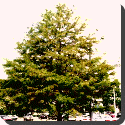 Bald Cypress — Taxodium distichum (Baldcypress, Bald Cypress, or Swamp Cypress) is a species of conifer native to the southeastern United States.
Bald Cypress — Taxodium distichum (Baldcypress, Bald Cypress, or Swamp Cypress) is a species of conifer native to the southeastern United States.
It is a large tree, reaching 25–40 m (rarely to 44 m) tall and trunk diameter of 2–3 m, rarely to 5 m. The bark is gray-brown to red-brown, shallowly vertically fissured, with a stringy texture. The leaves are borne on deciduous branchlets that are spirally arranged on the stem but twisted at the base to lie in two horizontal ranks, 1-2 cm long and 1-2 mm broad; unlike most other species in the family Cupressaceae, it is deciduous, losing the leaves in the winter months, hence the name ‘bald’. It is monoecious. Male and female strobili mature in about 12 months; they are produced from buds formed in the late fall, with pollination in early winter. The seed cones are green maturing gray-brown, globular, 2-3.5 cm in diameter. They have from 20–30 spirally arranged four-sided scales, each bearing one or two (rarely three) trianglular seeds. The number of seeds per cone ranges from 20–40. The cones disintegrate when mature to release the large seeds. The seeds are 5-10 mm long, the largest of any species in the cypress family, and are produced every year but with heavy crops every three to five years. The seedlings have 3–9 (most often 6) cotyledons.
It is a very popular ornamental tree, grown for its light, feathery foliage and orange-brown fall color. In cultivation it thrives on a wide range of soils including well-drained sites where it would not grow naturally due to the inability of the young seedlings to compete with other vegetation. Cultivation is successful far to the north of its native range, north to southern Canada. It is also commonly planted in Europe, Asia and elsewhere with temperate to subtropical climates. It does however require continental climates with hot summers for good growth; when planted in areas with cool summer oceanic climates, growth is healthy but very slow (some in northeastern England have only reached 4–5 m tall in about 50 years), and cones are not produced.
 Kids Portal For Parents India Kids Network
Kids Portal For Parents India Kids Network






